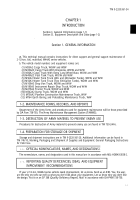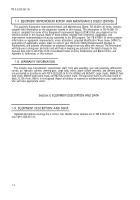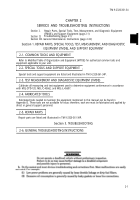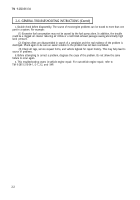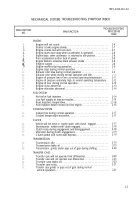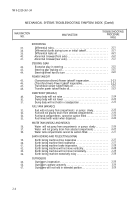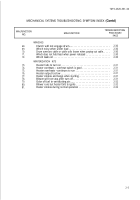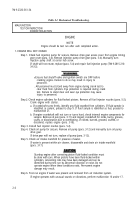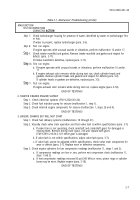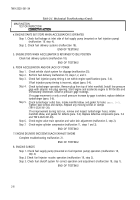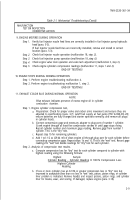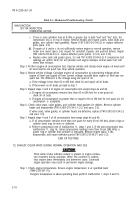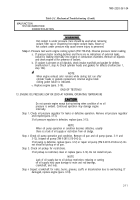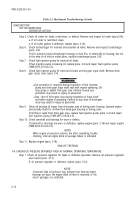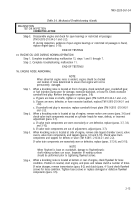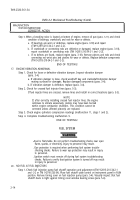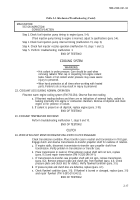TM-9-2320-361-34 - Page 24 of 764
TM9-2320-361-34
Table 2-1. Mechanical Troubleshooting (Contd).
MALFUNCTION
TEST OR lNSPECTlON
CORRECTIVE ACTION
9. ENGINE MISFIRES DURING OPERATION
Step 1.
Step
2.
Step
3.
Step
4.
Step
5.
Verify fuel injector nozzle feed lines are correctly installed in fuel injector pump hydraulic
head (para. 5-3).
If fuel injector nozzle feed lines are incorrectly installed, remove and install in correct
location (para. 5-3).
Check fuel injector nozzle operation (malfunction
18,
step
2).
Check fuel injection pump operation (malfimction
18,
step
6).
Check engine valve train operation and valve lash adjustment (malfunction 3, step 2).
Check engine cylinders compression readings (malfunction 11, steps 1 and
2).
END OF TESTING!
10.
ENGINE STOPS DURING NORMAL OPERATION
Step 1. Perform engine troubleshooting malfunction 4.
Step 2. Perform engine troubleshooting malfunction 1, step 2.
END OF TESTING!
11. EXHAUST COLOR BLUE DURING NORMAL OPERATION
NOTE
Blue exhaust indicates presence of excess engine oil in cylinder
combustion chamber.
Step 1. Engine cylinder compression test,
a.
b.
c.
d.
Preparation: Check for proper valve and rocker arms movement and ensure they are
adjusted to specifications (para. 3-7); cutoff fuel supply at fuel pump (TM 9-2320-361-20);
ensure batteries are fully charged and starter operates normally; and remove all plugs
in cylinder heads.
Connect compression gage and necessary adapter to plug port of number 1 cylinder.
Crank engine through at least five compression strokes or until gage stops rising.
Record cylinder number and maximum gage reading. Remove gage from number 1
cylinder. This is the “dry” test.
Repeat step 1b for remaining cylinders.
Add 1 to l-1/2 oz (29-44 ml) of clean engine oil through plug port for each cylinder before
connecting compression gage. Repeat steps 1b and 1c. This is the “wet” test. Record gage
readings for “wet” test beside readings for “dry” test for each cylinder.
Step 2. Analysis of compression test results.
a.
b.
Compute compression loss for “dry” test for each cylinder compared to cylinder with
highest reading using the following formula:
Highest
Sample
Cylinder Reading - Cylinder Reading X 100=% Compression Loss
Highest Cylinder
Reading
If one or more cylinders has an 8-10% or greater compression loss in “dry” test, but
improved to acceptable (less than
8%)
loss in “wet” test, piston, piston rings, or cylinder
liner problem is indicated. Remove head(s) and inspect pistons, piston rings, and cylinder
liner for breaks, wear, and scoring. If damaged, replace engine (para. 3-18).
2-9
Back to Top

